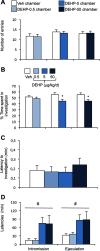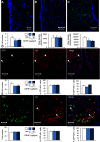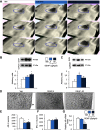Neural Mechanisms Underlying the Disruption of Male Courtship Behavior by Adult Exposure to Di(2-ethylhexyl) Phthalate in Mice
- PMID: 28934723
- PMCID: PMC5915199
- DOI: 10.1289/EHP1443
Neural Mechanisms Underlying the Disruption of Male Courtship Behavior by Adult Exposure to Di(2-ethylhexyl) Phthalate in Mice
Abstract
Background: Courtship behavior plays a critical role in attracting females and reproduction success. However, the effects of exposure to a ubiquitous contaminant di(2-ethylhexyl) phthalate (DEHP) on these behaviors and, in particular, on courtship vocalizations have not been examined.
Objective: The effects of adult exposure to DEHP on courtship and mating behaviors and gonadotropic axis and neural mechanisms involved in DEHP-induced effects were analyzed in male mice.
Methods: Adult C57BL/6J males were orally exposed to DEHP (0, 0.5, 5, and 50μg/kg/d) for 4 wk. Olfactory preference, ultrasonic vocalizations (USVs), partner preference and mating, as well as locomotor activity and motor coordination, were measured. The kisspeptin system and testosterone levels were analyzed. Proteomic and molecular studies were conducted on the hypothalamic preoptic nucleus, the key region involved in sexual motivation to vocalize and mate.
Results: DEHP at 50μg/kg/d reduced the emission of USVs, whereas lower doses changed the ratio of syllable categories. This was associated with diminished sexual interest of female partners toward males exposed to 5 or 50μg/kg/d and increased latency to mate, despite normal olfactory preference. The kisspeptin system and circulating testosterone levels were unaffected. In DEHP-exposed males, proteomic analysis of the preoptic nucleus identified differentially expressed proteins connected to the androgen receptor (AR). Indeed, exposure to 5 or 50μg/kg/d of DEHP induced selective AR downregulation in this nucleus and upstream chemosensory regions. The involvement of AR changes in the observed alterations was further supported by the reduced emission of courtship vocalizations in males with disrupted neural AR expression.
Conclusions: These data demonstrate the critical role of neural AR in courtship vocalizations and raises the possibility that the vulnerability of this signaling pathway to exposure to endocrine disrupters may be detrimental for courtship communication and mating in several species. https://doi.org/10.1289/EHP1443.
Figures

![Figure 2A is a bar graph with standard errors of mean plotting total number (y-axis) of short, flat, upward, and downward (simple group); modulated and complex (complex group); and mixed, one jump, and frequency jump (frequency jump group) syllables (x-axis) for the Veh and 0.5, 5, and 50 micrograms per kilogram per day DEHP exposure groups. Figure 2B comprises four pie charts showing the proportion of simple, complex, and frequency jump syllables in the Veh (29, 24, and 47 percent) and DEHP 0.5 (18, 25, 57 and percent), DEHP 5 (18, 28, and 54 percent), and DEHP 50 (29.5, 26, and 44.5 percent) exposure groups. Figure 2C is a bar graph with standard errors of mean plotting total duration (y-axis) of short, flat, upward, and downward (simple group); modulated and complex (complex group); and mixed, one jump, and frequency jump (frequency jump group) syllables (x-axis) for the Veh and 0.5, 5, and 50 micrograms per kilogram per day DEHP exposure groups].](https://cdn.ncbi.nlm.nih.gov/pmc/blobs/07da/5915199/899312a0d1d0/EHP1443_f2.gif)





Comment in
-
Love Song Blues: DEHP Alters Courtship Vocalizations in Mice.Environ Health Perspect. 2018 Jan 17;126(1):014001. doi: 10.1289/EHP2923. Environ Health Perspect. 2018. PMID: 29351545 Free PMC article. No abstract available.
References
-
- Andrade AJM, Grande SW, Talsness CE, Gericke C, Grote K, Golombiewski A, et al. 2006. A dose response study following in utero and lactational exposure to di-(2-ethylhexyl) phthalate (DEHP): reproductive effects on adult male offspring rats. Toxicology 228(1):85–97, PMID: 16996189, 10.1016/j.tox.2006.08.020. - DOI - PubMed
Publication types
MeSH terms
Substances
LinkOut - more resources
Full Text Sources
Other Literature Sources
Research Materials

